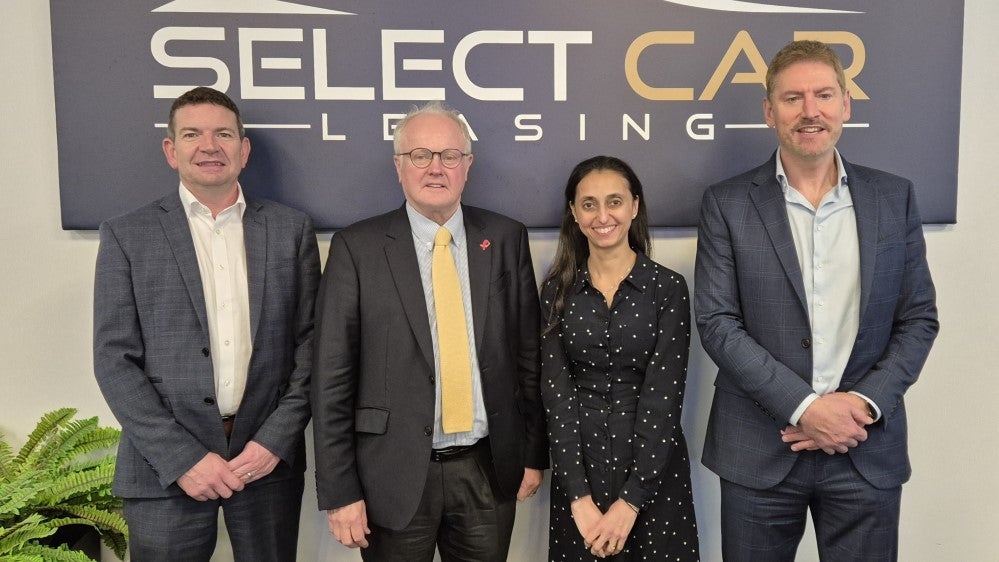Jo
Tacon talks to the board of Santander Consumer about the
company’s nought-to-60 entry into UK point-of-sale motor
finance
 Santander Consumer has not made much of a habit of shouting
Santander Consumer has not made much of a habit of shouting
about its achievements, in growing from a standing start in August
2005, when the business was established, to an annual new business
volume somewhere in excess of £1 billion today. But after a busy
year, which has seen the business develop relationships with a
batch of manufacturers – Fiat Group, Kia, and Mazda – while at the
same time completing the integration of GE Money’s motor lending
operations, managing director Vik Hill is ready to make a bit more
noise about Santander Consumer’s achievements, its development and
its plans for the future.
The second-largest independent motor finance
company in the UK, an offshoot of Spanish banking giant Santander,
has two UK offices: one in Leeds, and one in Redhill, Surrey. The
visitor to the Redhill office (which, incidentally, also houses
business financier Lombard, for which Hill worked for the better
part of 16 years, until 1998) is struck by the colour scheme: red
is everywhere, even down to the colour of the ties worn by male
staff members, a very visible reminder of the branding of Santander
Consumer’s parent bank.
In fact, Hill relates, Santander Consumer was the
first business in the UK to use the Santander name, which was much
less of an advantage in 2005 – when the name meant very little to
anyone other than readers of the business press – than it is today,
when Santander’s high-profile sponsorship of McLaren-Mercedes’
Formula 1 team, and particularly of Lewis Hamilton, have greatly
raised the brand’s name recognition levels, from less than 20
percent pre-sponsorship, to over 80 percent today.
“And, of course, for a very motor-focused business,
working closely with dealers, the F1 connection has been especially
resonant,” says Hill.
Following on from Santander’s higher profile,
thanks to the acquisitions of Alliance & Leicester and Bradford
& Bingley’s branch network and deposit base in 2008, the
company recently announced plans for three retail networks to take
on the Santander brand in 2010. With the Santander branding set to
appear on all 1300 branches of the parent bank by the end of next
year, the motor lender finds its name now opens more doors.
How well do you really know your competitors?
Access the most comprehensive Company Profiles on the market, powered by GlobalData. Save hours of research. Gain competitive edge.

Thank you!
Your download email will arrive shortly
Not ready to buy yet? Download a free sample
We are confident about the unique quality of our Company Profiles. However, we want you to make the most beneficial decision for your business, so we offer a free sample that you can download by submitting the below form
By GlobalData“Having the resources and being part of the world’s
fifth-largest bank is a great boost,” says Hill; Santander
Consumer, meanwhile, is present in 17 countries, which “shows
Santander’s commitment to the motor market – they’re really serious
about motor in Madrid,” he comments.
Starting from scratch
In late 2004, Hill was involved in
running off the First National (FN) portfolio, after Abbey, FN’s
owner, had decided motor finance was a ‘non-core’ activity “despite
the fact we were profitable,” Hill recalls in faint disbelief. But
later, when Abbey was bought by Santander, one of the new Spanish
owner’s first questions to its new UK subsidiary was about its
motor lending arm – or rather, its lack of one.
There was talk of reviving FN, but in the end, Hill
says, the decision was taken to make a fresh start, and to set up
Santander Consumer UK instead, with Hill as its managing director.
Graham Prestedge, also at FN, was named commercial director, while
Diane Roberts, again from FN, was appointed to the role of finance
director. Adam Goldhagen rounds out the current board as risk
director, with the post of technical/operations director still to
be filled, although a decision is “pretty close”, Hill says.
The fledgling company shared premises and staff
with FN.
“The day Santander Consumer was created, I switched
73 members of staff from FN over to the new company, then ‘hired’
them back to FN, where there was more need for their services – at
least at first,” Hill explains. “For staff involved in a period of
organisational change, there is nothing worse than uncertainty. So
by doing this, I aimed to minimise the disruption they
experienced.”
After the Abbey acquisition, a team from Madrid
came over to perform due diligence, Diane Roberts recalls.
“The questions they asked showed they had a good
understanding of such things as commission packages, defaults and
so on – demonstrating Santander’s deep knowledge of the motor
finance business,” she says.
Matters in motor finance had changed during Hill’s
absence from chasing new business, and he notes his “surprise” at
how far margins had declined when he returned to the market.
“There’s no point investing money in motor finance
unless the return is there,” he explains. “There was a period when
banks and so on would invest in a motor finance customer base in
order to cross-sell other products, but they soon found out they
couldn’t live like that unless the core product was
profitable.”
Hill echoes the sentiments expressed by other
leading motor finance figures, that the industry has to return to a
“sustainable” offering for all parties.
“Banks in the US abandoned point-of-sale [PoS]
motor finance as they couldn’t make a return. That hasn’t happened
here, thankfully, and returns are now somewhere close to where they
should be,” he observes.
Graham Prestedge adds: “We don’t want to take huge
profits out of the dealer network, as this will cause long-term
problems. But the faith of our parent bank can be seen in the
significant investment of capital they have made in this market.
The fact that we have always delivered the numbers we said we
would, and are now profit-making, vindicates that faith.”
The international
dimension
Santander Consumer’s presence in motor
finance markets in 17 countries brings certain advantages to the UK
operation, although Hill is adamant that a ‘one size fits all’
approach across different territories will not work, and national
outposts must have “flexibility” to adapt to local conditions.
“For example, when we explained the concept of
voluntary terminations to the people from Madrid, their reaction
was, ‘the customer can do what?!’,” Hill says dryly.
But some elements are transferable, with the UK
operation able to provide “a learning curve” for other businesses
within the group and to learn from them.
“It’s never a wasted flight to Madrid,” Hill muses.
“You always pick up something that makes you challenge your
assumptions. Up until four years ago, I had only ever worked for UK
banks, but it’s great having the back-up provided by an
internationally-focused parent.”
Technology and systems is one area where Madrid’s
expertise and resources are coming in handy, Hill says.
“Santander’s team rebuilt what we had, with significant
enhancements, and the front- and middle-end systems are run out of
Spain,” he adds. The back-end, meanwhile, is a bit older, but
“bulletproof”.
Integration is key
Since January, the board has been working
“flat-out” to complete the integration of the GE Money auto loan
portfolio, acquired on January 7, to migrate over its staff, to
rebrand the joint business – and to achieve a 10 percent growth in
turnover.
“Before the acquisition, GE Money and Santander
Consumer would have collectively written around £1 billion of new
business annually, and we will improve on that number this year”
Hill says. “Having said that, we are not in the volume game for
volume’s sake; our parent expects us to focus very clearly upon
profitability.”
Speed and decisiveness have been the watchwords
when bringing together the two businesses; it was necessary to
close some GE’s offices, Hill says, but affected staff were told
“upfront” – as that had been a valuable lesson from the FN
experience.
The first half of this year was dedicated to the
integration, which had four stages: firstly, separating out the
motor business from GE Money’s larger cards portfolio; then,
creating one company out of two, operating from two sites; next,
the companies migrated to a single IT and telephony platform, which
as far as dealers and customers are concerned has already
happened.
The only outstanding stage of the process yet to be
completed is the migration of the existing GE Money book to the
Santander Consumer platform, which is “on track to take place by
the end of March 2010,” Hill says. In fact, so far advanced is the
integration process that it is no longer an active project – the
majority of the heavy lifting has already been done.
The integration of the two companies’ cultures has
been a less visible, but no less important task, Hill adds.
“You don’t necessarily want one dominant culture to
take over, as you then lose the good bits of the other culture.
Ideally, you want a mix of the best parts of both,” he says.
The GE staff had been very “process-driven”, he
notes, and very focused on efficiency and structure; they were
initially somewhat surprised by the flatter management hierarchy of
Santander Consumer, with its shorter communication lines, and
relatively greater speed in decision-making.
The GE Money deal brought along with it a
white-label agreement for retail and wholesale funding for Kia and
its dealer network, while a similar, separate deal with Mazda was
struck mere days after the GE announcement. The timing was somewhat
less than perfect, Hill concedes, “but you have to take
opportunities as they come, and both made perfect sense to us.”
The scrappage scheme, later in the year, proved the
worth of both Mazda and Kia’s tie-up with Santander Consumer – as
major beneficiaries of the scheme, thanks to their good-value
appeal to the car buyer, Mazda, Kia and their dealers saw sales
volumes boom, with a corresponding rise in wholesale funding
requirements.
“We’ve done a lot in a short space of time, with
new staff coming in,” says Prestedge. “On top of that we’ve been
putting the businesses together during a time when the market is
changing dramatically. Because of that, we’re looking to make what
we’ve got profitable rather than chase new toys – sustainability is
our top priority.”
Bottom line focus
Santander, as a bank, is famous for its
profit and loss (P&L) focus, says Hill, and this philosophy has
been adopted wholeheartedly by the motor finance business. Sales
teams are paid commissions which depend on profit performance,
rather than volume, for example, while all middle managers have
been sent on P&L training courses to teach them how to read
balance sheets, and to drive home the impact of costs on the bottom
line.
This focus on sustainable, profitable business has
led Santander Consumer to introduce new scorecards and new lending
criteria, says Adam Goldhagen, at the same time as the company
undertook a review of dealer segmentation, “to understand in
greater detail the quality of the dealers we work with”.
“The scorecard is an indicator of credit quality,”
Goldhagen explains, “but there is much marginal business to be
gained – when a marginal application comes in, we can look at the
dealer who sent it, and see if he buys into the partnership
approach. If he does, that gives our underwriters a little more
confidence, and a little more latitude.”
Prestedge adds: “The relationship between risk and
sales has to bring in the dealer. We are looking at our dealer
database to find out who we want to flex our underwriting for,
which means building long-term relationships.”
The new card was developed in Madrid, and allows
the lender to “write more business, for less risk, and more profit”
– which sounds almost too good to be true, although Goldhagen
affirms that this is indeed the case. Santander Consumer works with
over 5,000 UK dealers; 95 percent of its business comes via its
web-enabled dealer systems, and 80 percent is automatically
underwritten.
As regards pricing for risk, Hill believes that “it
is the route the market has to go down” – but that the danger will
always be that one company will break ranks in order to pick up the
best business, and cause the whole model to fall down, thanks to
the laws of adverse selection.
Prestedge comments: “We have more than enough to do
at the moment, so pricing for risk is something we may look at in
the future – but not now.”
Future outlook
The company’s plan for next year is to
grow at a controlled pace, while tidying up the last stages of the
integration process. Hill is open to the idea of new partnerships
with manufacturers, but accepts that these will happen “when they
want to happen, not necessarily when you’d like them to
happen.”
He believes that fixed-cost motoring is worth
investing in, as offering a “total cost of motoring” to customers –
including insurance, maintenance, loan repayments, and a host of
other extras – gives them peace of mind during a recession.
The biggest threat, as Hill sees it, is a return to
the “bad old days” of margins too thin to live on.
“We have to change the profit share mindset, so
that lenders and dealers both get a fair slice of the pie, while
customers get a robust and credible offering,” he underlines.
“There will always be a market for PoS – it’s convenient, safe, and
well-priced.”
Overall, though, he seems very happy with his job,
his team, and the outlook for Santander Consumer in the UK.
“I thought I would wind up FN, then go home – to
get the call to start up Santander Consumer was just great. We had
a fresh start, and were able to put into the new business exactly
what we thought would work,” Hill says. “We’ve made mistakes, of
course – who hasn’t? – but we’ve put our money where our mouth is,
and have a close-knit board and management team, most of whom have
been together since the business was formed.”
As part of Europe’s largest bank, the board as a
whole are very positive about the future, and keen to make the most
of the Spanish connection.
“We have Spanish lessons every Wednesday,” Hill
points out.
Along with the red ties, the red carpets and the
big red sign on the Redhill office, it’s a sign that Santander
Consumer is certainly making its mark in the UK.







